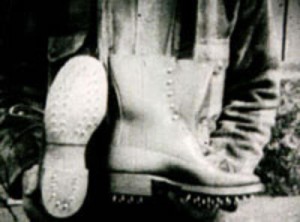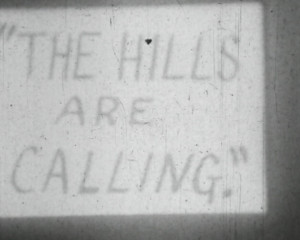"Various shots of a dog doing tricks - begging for a ball; jumping over a metal pole and rolling over on its back. Concludes with shots of a woman taking a dog for a walk down a country lane." (NWFA Online Database)
"the first talking film ever made by amateurs and exhibited publicly. The film is a sincere attempt to make a thriller of the popular kind. Its producers… ask it to be accepted as such, and stress the fact that it has no pretensions to art. They would also have you bear in mind the fact that the film was made by eleven London amateurs, who had never played in a film before, and that they total resources were £20… it is interesting to note that the hero of “Shadows of Limehouse” applied for, and obtained, the part created by Owen Nares in “The Middle Watch”, and that he is now on tour with that production" (M.A.L.B. 1931: 7).
"This amateur society [Apex Motion Pictures], the oldest in London, made and publicly exhibited the first amateur talkie in England (and, it is believed, the world). That was in January 1930 when, before an audience which included Mabel Poulton, John Stuart, and other famous British stars. “Shadows of Limehouse”, a film of thrills introducing the Flying Squad, has since been cut for silent showing by other groups and is still being exhibited. When it was shown recently in aid of Tunbridge Wells Hospital, a local cinema proprietor asked the organisers to take it out of the programme in order to give his show a chance of doing some business!" (Anon 1932: 108).

"Depicts the year-round activities of the Machias Lumber Company on the Machias River in Washington County, Maine. Includes scenes of winter logging in the forest with hand tools and horses, as well as the spring log drive, with loggers using peaveys to break up log jams on icy rivers as the logs are moved from the forest to the mill. Includes footage of lumber loaded onto schooners in Machias for transport to New York and schooner being towed to sea by sardine boat." oldfilm.org
"A German airman is boarding at a house in England. The landlady tells him about her daughter's death; she was killed in an air raid on her seventeenth birthday. As he hears the story, he remembers that day and that he was dropping bombs on the area. When he sees her portrait, he runs from the house and the landlady's son Rudolph runs after him. He chases him across the clifftops and the German sees a vision of the daughter. He tries to embrace her but stumbles and falls off the cliff. Rudolph also sees his sister, they laugh, embrace and he throws stones at the German who is clinging to a tree root. Rudolph's vision disappears and he runs down to rescue the German but he is already dead" (BFI online).
"Mr Terence L. Greenridge writes to tell me that the film “Afterwards”, for which he and his wife Nora [Pfeil] Greenridge, are jointly responsible, has been taken back for the sake of certain additions, previous for general release to amateur societies. Mr Terence Greenridge is better known in the amateur film movement as the first filmmaker in Oxford University, and as author of the recently published “Degenerate Oxford!” For some time he has been a leading light of the London A.C.A. Mr Terence Greenridge did the secondary jobs of “Afterwards”, such as scenarising, choosing locations, and working out camera angles. This film, which had a particularly successful premiere at the London A.C.A.’s public show, is not merely the London A.C.A.’s most ambitious production for 1930, but is also something rather new in cinematography, whether professional or amateur. It has something of that imaginative audacity for which I have already pleaded, and it is, very largely, the work of a woman."
"Telling Situations - In too many cases a film has to attempt to justify a conventional plot. In this case the plot makes the film. Nora Greenridge, who wrote the story, possesses a natural instinct for a telling situation: even when, as in this case, the theme came to her in a dream. In “Afterwards” there is nothing of the sentimental, conventional world of nine films out of ten, where the hero is never allowed to die unless it is obvious that life has not more to offer him. The good looking hero of “Afterwards” dies at the prime of life, full of vitality, and in “Afterwards” the dramatic conflict is between man’s muddle-headed kindliness and the precise retribution of the supernatural world: so precise that, on occasion, it can become cruelty. The film is not calculated to induce placid happiness in an audience, but rather to challenge them to think about the deeper problems of life. Treatment has been subordinated to theme. There is no stunting in this film. Camera-angles and backgrounds were selected in so far as they might elucidate the episode which was being pictured, and not for intrinsic excellences that they might posses in themselves. The beauty of the English countryside finds expression in “Afterwards”, but Nora Greenridge has utilised it in a purposeful manner, understanding how grim events become twice as grim, if they happen in beautiful surroundings."
“Happy Ever After - Nora Greenridge not only wrote the story and directed its production, but played a part, to quote one of the critics, “with sylph-like grace”. Mrs Greenridge, or Nora Pfeil as she used to be, is an attractive blonde and has played several leading roles in London A.C.A. productions. She has also won many awards in scenario competitions. She became engaged to Terence Greenridge a quarter of the way through the production, and halfway through the production their marriage took place. Now they have a house called “Afterwards”—a happy and true modern version of the age-old fairy-tale ending" (M.A.L.B. 1931, 9).
"One of the films being shown [as part of the All-English Amateur Film Week] has been referred to as the most ambitious production of 1930. Produced by Terence Greenridge, better known as an author, directed by Miss Nora Pfeil, who has since become Mrs Greenridge, “Afterwards” is certainly a film none should miss. Plots should not be given away in advance, so let it be said that a German Professor came to England in 1928 on a geological holiday. He settled down with an English family, the daughter of which had been killed in an air-raid over London ten years previously, and the son rendered neurotic. The family generally “took to” the German, who was a sociable enough fellow. They forgot the war, but as the tenth anniversary drew near—It is a film well worth seeing" (Anon 1931, 9).
"An intertitled travelogue film of a trip to Australia starts with a map showing the journey from London to Australia, followed by views at different stages of the route" (SASE online).

"The first film shot by Laurie and Stuart Day. The film records details of a trip to Germany in 1930 made by Laurie and Stuart Day with Laurie Day’s father, John Wood Jones" (EAFA Database).

"Amateur filmmaker, cinema historian and railway engineer H.A.V. Bulleid employs a grim sense of humour to show the lengths to which a young man will go to make money. Out walking in the fields, a boy comes across a steep drop, and sitting on the clifftop, he hatches a foolproof money making scheme. Advertising for people to 'Come and see a 'death leap'', he charges 6d entry. As the crowd assembles on the clifftop, an unwitting patron is urged to move backwards, stumbling over the edge. Happy with the success of his scheme, the boy sits in the grass, clutching the money in his pocket" (EAFA Database).
Total Pages: 299